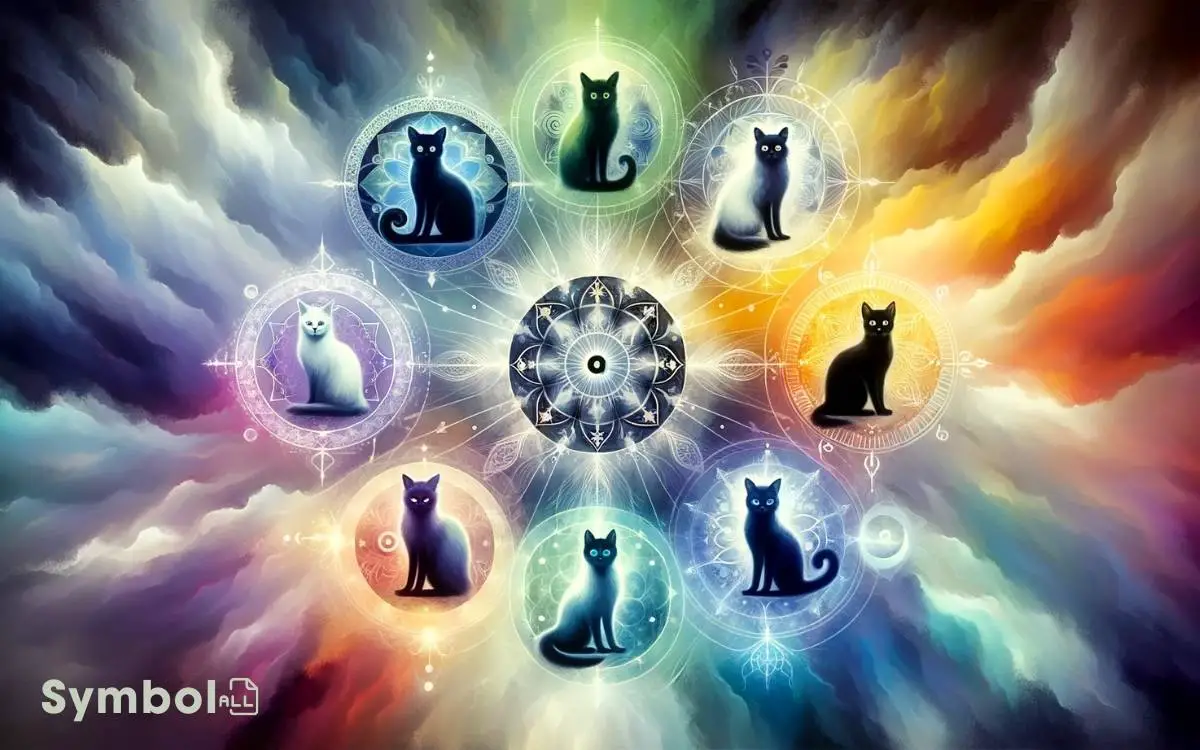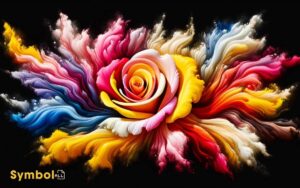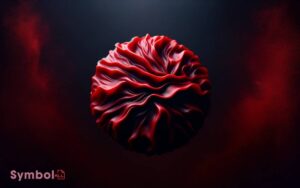Symbolic Cat Color Meanings Spiritual: A Comprehensive Guide
You’ve probably noticed that cats come in an array of colors, each carrying its own spiritual symbolism.
- Black cats, shrouded in superstition, oscillate between omens of bad luck and protectors against evil.
- White cats, in contrast, embody purity and good fortune, a symbol of peace across cultures.
- Orange tabbies channel energy and vibrancy, often associated with divine connection.
- Grey cats, with their balanced demeanor, act as mediators between worlds, promising harmony.
Each color reveals a layer of cultural belief and spiritual significance, illuminating cats’ roles as both mundane pets and mystical beings. Understanding these color-coded messages opens a gateway to deeper spiritual insights.

Key Takeaway
Exploring Cat Color Symbolism and Spiritual Meanings
| Cat Color | Spiritual Meaning | Cultural Association | Notes |
|---|---|---|---|
| Black | Mystery, magic | Bad luck (Western), good luck (Japanese, British) | Often associated with witches and Halloween |
| White | Purity, peace | Good luck, positive outcomes | Seen as a good omen in many cultures |
| Red/Orange | Energy, playfulness | Happiness, success (Eastern) | Commonly associated with vibrant personalities |
| Blue/Grey | Calmness, serenity | Wisdom, nobility | Often linked to peaceful and stable characters |
| Calico/Tortoise | Good fortune, luck (especially in Japan) | Creativity, free-spiritedness | Traditionally believed to bring good luck |
| Tabby | Groundedness, earthiness | Sacred (Ancient Egyptian), luck (Islamic) | Known for the distinctive “M” on their forehead |
| Siamese (color point) | Mystery, exoticness | Royalty (Thailand), elegance | Valued for their striking appearance |
The Enigmatic Black Cat
Traversing through history, black cats have symbolized mystery and superstition across various cultures, often reflecting society’s evolving attitudes towards these enigmatic creatures.
You’ll find that in some regions, they’re considered harbingers of bad luck, while in others, they’re seen as protectors against evil spirits.
This dichotomy isn’t just a matter of folklore; it mirrors the complex ways humans interact with symbols in their environment.
Analyzing these beliefs ethnographically, one notices a pattern: cultures with a strong witchcraft narrative often vilify black cats, associating them with sorcery. Conversely, societies valuing night-time protectors view them favorably.
This comparative perspective underscores not just the arbitrary nature of these symbols but also how deeply intertwined they’re with human culture and psychology, offering a window into the collective psyche.
Pure White Felines
In stark contrast to their shadowy counterparts, pure white felines often embody purity, peace, and good fortune across various cultures, revealing how societal values shape our perceptions of color in animals.
You’ll find that in Japan, a white cat is a symbol of good luck, particularly for those seeking prosperity and happiness.
Similarly, in ancient Egypt, white cats were revered, associated with the goddess Bastet, representing protection, family, and domestic harmony.
This cross-cultural reverence highlights a shared human inclination to imbue animals with symbolic significance based on their physical attributes.
Yet, it’s important to recognize that these meanings aren’t universal. In some folklore, white cats are believed to forecast illness or misfortune, demonstrating how context drastically alters symbolic interpretation.
Fiery Orange Tabbies
Orange tabbies, with their striking coat patterns, often symbolize energy and vibrancy in various cultural narratives, reflecting a fascinating interplay between color perception and symbolic value.
You’ve likely noticed how these cats stand out, not just for their appearance but for the folklore and beliefs surrounding them.
| Culture | Symbolism |
|---|---|
| Ancient Egypt | Divine connection |
| Celtic | Good fortune |
| Japanese | Happiness |
| American | Adventure |
Their bright fur is not just a matter of genetics; it’s a canvas for cultural projection. Analyzing these associations, you find a common thread: orange tabbies are consistently linked with positive attributes.
This isn’t mere coincidence; it’s a demonstration of how humans universally gravitate towards light and warmth, qualities abundantly found in the fiery hues of orange tabbies.
The Mysterious Grey Cat
As you explore the enigmatic world of grey cats, you’ll find that their coloration isn’t just a matter of genetics but also carries rich symbolism and spiritual significance across cultures.
Unlike the fiery orange tabbies, which often embody energy and warmth, grey cats are frequently associated with mystery, balance, and a subtle form of grace.
This comparison invites you to contemplate how cultural interpretations of cat colors shape our understanding of these creatures and their place in human society.
Grey Cat Symbolism
Delving into the symbolism of grey cats, you’ll uncover a tapestry of mystery and allure that transcends cultures and historical periods.
Grey, a color often associated with neutrality and balance, lends itself to the depiction of grey cats as symbols of harmony and stability in many societies.
In some cultures, these felines are seen as mediators between the physical and spiritual worlds, embodying a bridge that connects the known with the unknown.
This perception isn’t uniform, though. Ethnographic comparisons reveal that while some communities view grey cats as omens of good luck and prosperity, others regard them with suspicion, associating their color with fog, uncertainty, and the unseen.
Through this comparative lens, it’s clear that grey cats carry a nuanced symbolism, shaped by the cultural contexts in which they’re perceived.
Spiritual Significance
Within the domain of spiritual symbolism, grey cats hold an enigmatic position, often seen as guardians of the threshold between life and death.
You observe their presence across various cultures, where they’re revered as mystical entities capable of traversing spiritual dimensions.
In some traditions, they’re believed to ward off evil spirits, serving as protectors for their human companions.
This protective role is contrasted with their representation in other cultures as harbingers of change or transformation, embodying the fluidity and ambiguity of life’s constant flux.
Comparatively, while black cats are often associated with bad luck, grey cats elicit a more nuanced understanding, embodying balance and neutrality.
They symbolize the middle ground, encouraging you to look beyond the surface and appreciate the complexity of spiritual connections.
This multifaceted symbolism highlights their unique role in spiritual beliefs, offering a deeper insight into the intricate relationship between humans and the metaphysical world.
Calico Cats: A Triad of Meanings
You’ve likely heard of calico cats being seen as symbols of luck, but the layers of meaning attributed to their tricolor coats extend beyond mere superstition.
Across cultures, the diversity in calico symbolism reflects broader societal beliefs and values, offering a unique lens through which to examine human-animal relationships.
This exploration into their spiritual significance further reveals how calicos have been interwoven into the fabric of folklore and tradition, embodying complex narratives that transcend their physical appearance.
Calico Cats Luck Charm
Many cultures view calico cats as symbols of good luck, weaving a complex tapestry of beliefs and stories around their distinct tri-colored fur.
This perception isn’t just based on their striking appearance; it’s deeply embedded in folklore and tradition, offering a fascinating glimpse into how animals can embody cultural values and superstitions.
- Japan: Believed to protect against misfortune, calico cats are especially revered in Japanese culture, where they’re considered to bring good luck to their owners.
- United States: Associated with fortune and prosperity, owning a calico cat is sometimes seen as a charm for wealth.
- Ireland: Thought to ward off evil spirits, calico cats hold a special place in Irish folklore.
- Egypt: Ancient Egyptians valued all cats, including calicos, for their protective qualities and viewed them as sacred.
Analyzing these beliefs highlights a shared cultural appreciation for calico cats, underscoring their unique role as bearers of luck and protection across different societies.
Diversity in Calico Symbolism
Exploring the symbolism of calico cats reveals a rich tapestry of meanings that varies considerably across cultures, each adding its own layer to our understanding of these tri-colored animals.
In Japan, calico cats are seen as omens of good fortune, particularly for sailors who believe these cats can protect against misfortune at sea.
Contrastingly, in the United States, they’re often viewed as a symbol of luck, without the specific maritime association.
Meanwhile, in Celtic folklore, calico cats are considered a harbinger of change, signaling transformations and the crossing of thresholds.
This diversity in symbolism highlights not just the cultural significance of calico cats but also the broader human tendency to imbue animals with meaning based on localized beliefs and experiences.
Spiritual Significance Explored
Beyond the varied cultural interpretations, calico cats carry profound spiritual significance, embodying a triad of meanings that resonate deeply across different spiritual practices.
In understanding these vibrant creatures, you uncover layers of spiritual insight:
- Balance: Their unique coat symbolizes the equilibrium between light and darkness, physical and spiritual worlds.
- Luck: Many cultures view calicos as harbingers of good fortune, transcending mere superstition and touching spiritual domains.
- Change: Their distinct markings represent the ever-changing nature of life, encouraging adaptation and acceptance.
- Harmony: The blend of colors on calico cats symbolizes unity in diversity, promoting peace and cohesion in varied spiritual communities.
This comparative exploration reveals how calico cats serve as spiritual guides, weaving together themes of balance, luck, change, and harmony, echoing universal truths across cultures.
The Rare and Regal Blue
In the palette of feline coats, the blue hue, often a dilute gray, exudes a sense of regality and rarity that captures the imagination.
This particular coloration, unlike the more commonly observed shades in cats, carries a mystical aura.
Historically, cultures have associated various meanings with this serene color, viewing it as a symbol of nobility and an indicator of a calm, collected temperament.
When you observe blue cats through an ethnographic lens, it’s evident that they’re not just pets. They’re living symbols, embodying tranquility and grace.
Comparatively, while other colors signify warmth, playfulness, or mystery, blue stands alone, reflecting a unique blend of serenity and majesty.
This rare coat color invites you to explore further into the spiritual significance behind feline hues, prompting a quest for understanding beyond the superficial. Known for its striking appearance, this unusual hue often carries deep meanings tied to mysticism and ancient traditions. The symbolism of scarlet color, for example, has long been associated with passion, transformation, and a connection to the divine. Exploring these themes through the lens of feline coat colors offers a fascinating glimpse into the interplay between nature and spiritual beliefs.
Tuxedo Cats: Duality Personified
Tuxedo cats, with their striking black and white markings, embody a striking duality that mirrors the complexity of their personalities.
This contrast isn’t merely superficial; it extends into the very essence of how these cats interact with the world and their human companions.
Through an analytical, ethnographic lens, you’ll find that:
- Tuxedo cats often display a blend of independence and affection, maneuvering their environments with a unique grace.
- Their coloration symbolizes balance, reminiscent of the yin and yang, suggesting a harmonious blend of opposites.
- Observationally, they seem to exhibit a higher level of intelligence and curiosity compared to other color variants.
- Culturally, they’ve been revered as symbols of good luck and prosperity in various societies.
This comparative analysis reveals how tuxedo cats stand as living symbols of duality and balance, enriching our understanding of feline mystique.
Tortoiseshell Cats: A Symbol of Fortune
Shifting our focus, let’s explore how tortoiseshell cats, with their distinctive mottled coats, emerge as symbols of fortune and bring a unique cultural significance to the feline world.
In various cultures, these cats are revered not just for their striking appearance but also for their supposed mystical qualities.
Historically, sailors believed tortoiseshell cats could protect against storms at sea, a belief that illustrates their perceived power to influence fate.
This contrasts with other cat colors, which might carry associations with luck or misfortune, but rarely are they thought to wield such protective powers.
Ethnographically, the tortoiseshell cat’s status varies globally, yet the common thread is their association with good luck and prosperity.
It’s a fascinating reflection of how color and pattern in animals can transcend mere aesthetics to embody deep cultural and spiritual meanings.
The Spiritual Significance of Cream Cats
Cream cats carry a serene aura, often symbolizing peace and spiritual awakening in various cultures. Their gentle coloration isn’t just a matter of beauty but carries deep spiritual meanings.
When observing these creatures, one can’t help but feel a sense of calmness and tranquility, which is why they’re highly regarded in spiritual circles.
- Inner Harmony: Cream cats are believed to embody inner peace, guiding individuals towards serenity.
- Healing Presence: Their presence is often associated with healing and comfort during times of distress.
- Spiritual Awakening: They symbolize the beginning of a spiritual journey, encouraging self-discovery.
- Universal Love: Cream cats represent unconditional love, reminding us of the importance of compassion and empathy.
Analyzing their influence, it’s clear that cream cats are more than just pets; they’re spiritual companions guiding us towards a more peaceful existence.
Bi-Color Cats: Harmony and Balance
As you explore the world of bi-color cats, you’ll find they’re often seen as living embodiments of the yin-yang, showcasing a perfect equilibrium between two forces.
Their distinct coat patterns symbolize emotional stability, offering a unique lens through which to view their calming influence on human companions.
This dual nature provides insights into the complex interplay of opposites, mirroring the dynamic balance found in many cultures’ philosophies.
Yin-Yang Representation
Bi-color cats, embodying the yin-yang principle, serve as a dynamic representation of harmony and balance in various cultures.
These creatures, with their distinct patches of color, symbolize the ancient concept of dualism—where opposite forces are interconnected and interdependent in the natural world.
Analyzing their symbolic significance offers insights into how different societies perceive the world around them.
- Cultural Interpretation: Different cultures view bi-color cats through the lens of their unique spiritual and philosophical traditions.
- Balance and Harmony: These cats are often seen as living embodiments of balance, promoting a sense of peace and equilibrium.
- Opposites Attract: They illustrate the principle that opposites not only coexist but thrive together, fostering a deeper understanding of unity amidst diversity.
- Spiritual Symbolism: In spiritual contexts, they’re considered messengers of change and adaptability, encouraging a harmonious blend of varying energies.
Emotional Stability Symbol
In many cultures, you’ll find that bi-color cats aren’t just admired for their physical beauty, but are also revered as symbols of emotional stability, epitomizing the perfect balance between serenity and dynamism.
This perception stems from an analytical look at how these cats’ contrasting colors represent the harmonious blend of opposing forces, much like the pursuit one aims for in emotional well-being.
Ethnographically, different societies may interpret the specific colors of bi-color cats in various ways, yet the overarching theme of balance remains constant.
Comparative studies show that, unlike solid-colored felines, bi-color cats uniquely symbolize a state of equilibrium, suggesting that their presence can inspire a sense of calmness and groundedness in humans.
This insight into the symbolic significance of bi-color cats offers a deeper understanding of their role as emotional stabilizers across cultures.
Dual Nature Insight
Exploring the dual nature of bi-color cats reveals how they embody the intricate balance between harmony and conflict, serving as living symbols of unity amidst diversity.
Their contrasting colors aren’t just a matter of aesthetics; they represent the constant interplay between opposing forces in our lives.
Analyzing their significance offers a deeper understanding of balance:
- Yin and Yang: Each color symbolizes the dual aspects of life, reminiscent of the Yin and Yang, promoting a sense of equilibrium.
- Personal Growth: Encourages embracing all parts of oneself, acknowledging both strengths and weaknesses.
- Cultural Reflection: Across cultures, bi-color cats are seen as omens of good fortune and balance.
- Emotional Harmony: Suggests the importance of maintaining emotional stability amidst life’s ups and downs.
Bi-color cats, then, aren’t just pets but profound symbols of life’s complexity and beauty.
The Alluring Golden Cat
The allure of the golden cat captivates many, embodying wealth and prosperity across various cultures.
In your quest for understanding, you’ll find that golden cats aren’t just a symbol of material wealth but also spiritual abundance.
Historically, societies have often associated gold with the divine and the eternal. It’s no surprise then that golden cats are seen as bridges to spiritual domains, offering protection and guidance.
Comparatively, while other cat colors might represent mystery or healing, the golden cat stands out for its connection to higher values and the pursuit of enlightenment.
Ethnographically, these beliefs span continents, from the golden idols of Ancient Egypt to the lucky Maneki-neko of Japan.
Each culture imbues these shimmering felines with a unique significance, yet all converge on themes of fortune and transcendence.
Siamese Cats: Mystique and Myth
Often shrouded in mystery, Siamese cats carry a rich tapestry of myths and legends that have fascinated cultures worldwide.
Originating from Thailand, formerly Siam, these cats are more than their striking blue eyes and sleek coats.
- Siamese cats were believed to house the souls of deceased royals, serving as spiritual guardians.
- Their distinctive color points were said to be the fingerprints of the gods.
- In Thai folklore, they’re symbols of protection, warding off evil spirits from households.
- Historically, Siamese cats were so revered that they were only owned by royalty and monks.
This deep cultural reverence highlights the unique intersection of spirituality, status, and the animal kingdom, showcasing how Siamese cats transcend their physical beauty to embody significant spiritual and cultural roles.
The Protective Power of Tabby Cats
Just as Siamese cats hold a revered place in Thai culture, tabby cats too are cloaked in their own protective mythology, serving as guardians against unseen threats in various traditions.
This stems from their distinctive markings, which some believe to be imbued with magical properties.
Across cultures, tabbies are often associated with good fortune and are thought to ward off evil spirits.
In ancient Egypt, for instance, their likeness to the sacred Bastet, depicted often with similar markings, granted them a protective aura.
Comparatively, in European folklore, a tabby’s pattern was sometimes believed to represent the eyes of their ancestors, watching over and protecting their human companions.
This cross-cultural reverence highlights a universal belief in the tabby’s ability to offer protection beyond the spiritual dimension.
Albino Cats and Spiritual Purity
You’ve likely noticed that albino cats carry a unique aura, often seen as symbols of innocence across various cultures.
Their striking appearance lends them a spiritual significance, positioning them as pure beings in the eyes of many.
Comparing cultural perceptions reveals a fascinating tapestry of beliefs, highlighting how these cats are revered or mystified around the globe.
Albino Cats: Symbolizing Innocence
In many cultures, albino cats are revered as symbols of purity and innocence, reflecting a deep spiritual significance.
Their striking appearance, characterized by their white fur and often light-colored eyes, sets them apart, imbuing them with a mystical aura.
This has led to a variety of beliefs and interpretations regarding their presence:
- Spiritual guardians: In some traditions, they’re seen as protectors against negative energies.
- Harbingers of good luck: Their rarity makes them symbols of fortune and blessing.
- Emblems of new beginnings: Their pristine appearance symbolizes a clean slate.
- Healers: It’s believed their presence can offer comfort and healing.
These perspectives highlight how albino cats aren’t just admired for their physical uniqueness but are deeply intertwined with spiritual and cultural narratives, embodying innocence and purity in a profound way.
Spiritual Significance: Pure Beings
Albino cats, often perceived as pure beings, hold a profound spiritual significance across various cultures, embodying themes of purity and transcendence.
These unique felines, with their striking white fur and light-sensitive eyes, serve as symbols of spiritual purity and otherworldly presence.
You’ll find that in many traditions, the rarity of albino cats imbues them with a mystical aura, suggesting a connection to the divine or the supernatural.
Their appearance, devoid of any color, is interpreted as a blank slate or a vessel for spiritual energy.
This notion positions albino cats as mediators between the physical and spiritual domains, potentially guiding human souls or serving as protectors against negative energies.
Their perceived purity elevates their status, marking them as special entities within the spiritual ecosystem.
Cultural Perceptions: Albino Cats
Why do different cultures revere albino cats, often associating them with spiritual purity and otherworldly qualities?
Across the globe, these rare creatures captivate us, often becoming central figures in spiritual and cultural narratives.
Let’s explore some reasons why:
- Rare Appearance: Their striking, unusual look sets them apart, making them seem magical or otherworldly.
- Symbol of Purity: The pristine white of their fur symbolizes cleanliness and innocence, traits highly valued in many spiritual practices.
- Mystical Associations: In some cultures, albino animals are thought to be physical manifestations of gods or spirits.
- Harbingers of Luck: Their rarity often translates into a belief that they bring good fortune or have protective powers.
Conclusion
To sum up, like a kaleidoscope shifting its colors, each cat breed weaves its own tapestry of spiritual significance across cultures.
- Black cats embody enigma, while white felines symbolize purity.
- Orange tabbies ignite with vitality, and grey cats cloak in mystery.
- Calicos blend diverse energies, goldens allure with majesty, Siamese enchant with their myths, tabbies protect, and albinos epitomize spiritual purity.
This comparative analysis reveals how these feline hues resonate with deep, ethnographic meanings, enriching our understanding of their spiritual symbolism.






